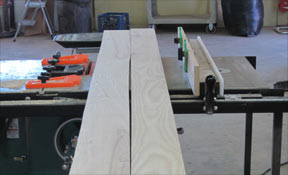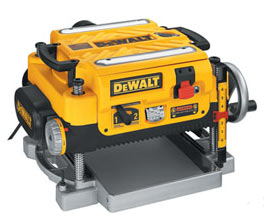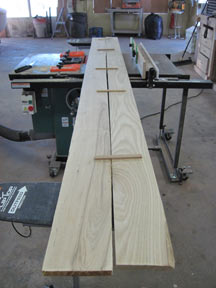Straighten out your wood
 When you first unrolled your boat plans you probably found different pieces of the boat which required various widths, sizes and shapes of lumber. For your boat building project, chances are your best bet for milling out all of the members is from lumber that will not come from the local big box store but rather a good old fashion lumber yard. One of the primary reasons for us working on this site is to pass along tips and techniques. Over the years, necessity has proved a great motivator to either research or develop techniques which allows us to build our boats. One such technique we had to figure out a long time ago was how to make a straight edge on a long piece of lumber. One realization that you come to very fast when looking for the best lumber to fill the need of your boat plans, is that it may very well be what is called "In the Rough". that simply means it goes from the saw conveyor to the shelf to you without having been planed or milled straight. It only takes one straight piece of lumber to make a whole pile of straight boards. As you can see from the picture, we have two boards atop of the table saw. the one to the right has a milled straight edge on two sides and the one on the left is something less than straight.
When you first unrolled your boat plans you probably found different pieces of the boat which required various widths, sizes and shapes of lumber. For your boat building project, chances are your best bet for milling out all of the members is from lumber that will not come from the local big box store but rather a good old fashion lumber yard. One of the primary reasons for us working on this site is to pass along tips and techniques. Over the years, necessity has proved a great motivator to either research or develop techniques which allows us to build our boats. One such technique we had to figure out a long time ago was how to make a straight edge on a long piece of lumber. One realization that you come to very fast when looking for the best lumber to fill the need of your boat plans, is that it may very well be what is called "In the Rough". that simply means it goes from the saw conveyor to the shelf to you without having been planed or milled straight. It only takes one straight piece of lumber to make a whole pile of straight boards. As you can see from the picture, we have two boards atop of the table saw. the one to the right has a milled straight edge on two sides and the one on the left is something less than straight.

Before you start this process, you need to make sure that each board is the same thickness. that is easily accomplished with a planer. It does not need to be a big heavy expensive floor model. My favorite planer is my Dewault which cost me about $300 and will handle up to a 13" board which is plenty wide enough for what we do. One decent size boat building project will pay for that planer if you purchase wood in the rough and plane it down yourself. I will warn you though that these things really throw off the chips. Decent surface planers, such as the Dewault will have an ejection port. On a good ejection port, you can simply run a hose from it to a barrel, however if you have a shop vac better yet, a dust collector, it does a better job.
 Once the boards are the same thickness, then it is a simple matter of attaching the board with the straight edge to the one with the crooked edge and running it through the table saw. Boat plans will call for different widths and lengths of wood and I rarely try to lay it all out before cutting. I Also don't like having screw holes in my wood as I mill members for the boat so I attach the two boards with small scraps of wood and hot melt glue. The bond is strong enough to get the job done and yet you can get them apart with a chisel when you are done.
Once the boards are the same thickness, then it is a simple matter of attaching the board with the straight edge to the one with the crooked edge and running it through the table saw. Boat plans will call for different widths and lengths of wood and I rarely try to lay it all out before cutting. I Also don't like having screw holes in my wood as I mill members for the boat so I attach the two boards with small scraps of wood and hot melt glue. The bond is strong enough to get the job done and yet you can get them apart with a chisel when you are done.
As a last suggestion, you can see from the pictures that there are three feather boards on the table saw. One feeding in, one at the blade and one on the out-feed. It is critical that you keep the board up against the fence when straightening out an edge. If the board you are straightening is so crooked that you simply can not get the feather boards to work, then simply make a first pass getting it close and then run it through again taking off just enough to get a perfect edge.
If done properly, you will find this technique to rival any big, bulky and expensive edge planer. Best of all it can be done with the tool that pretty much any handy home owner has in their basement or garage. Building your boat doesn't need a large shop stocked with lots of specialty tools, but sometimes building your dream boat does take a little ingenuity.


